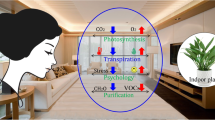Abstract
This work aims to provide an historical overview on aerobiology applied to the preventive conservation of cultural heritage. Bioaerosol represents a potential risk to cultural artifacts since in favorable nutritional and microclimatic conditions the settled biological particulate matter can develop and grow, thus triggering the biodeterioration. Aerobiology has become an important discipline for developing prevention and control strategies for the biological deterioration of cultural heritage. The most used equipment and methods for sampling in both indoor and outdoor environments (passive-sedimentation plates and active impactor for air, contact plates and membranes for surfaces) will be described. The aerobiological monitoring, always combined with microclimatic monitoring, along with information on the artifact and its conservation status, allows to defining situations of potential biologic risk. All the information and data gathered create the baseline for setting up management protocols, defining tailored corrective strategies aimed at preventing damage to cultural heritage and reducing risks to the health of operators and users. New perspectives for this discipline could arise thanks to (a) the development of user-friendly technologies and instrumentations for aerobiological monitoring and sampling of surfaces; (b) the definition of threshold levels of biological risk to the different types of cultural heritage; (c) the creation of a card of “biodeterioration risk” (international database).



Similar content being viewed by others
References
Apetrei, I. C., Drăgănescu, G. E., Popescu, I. T., Carp-Cărare, C., Guguianu, E., Mihăescu, T., et al. (2009). Possible cause of allergy for the librarians: Books manipulation and ventilation as sources of fungus spores spreading. Aerobiologia,25, 159–166. https://doi.org/10.1007/s10453-009-9121-y.
Bonazza, A., De Nuntiis, P., Mandrioli, P., & Sabbioni, C. (2017). Aerosol impact on cultural heritage: Deterioration processes and strategies for preventive conservation. In C. Tomasi, S. Fuzzi, & A. Kokhanovsky (Eds.), Atmospheric aerosols: Life cycles and effects on air quality and climate (pp. 645–670). Weinheim: Wiley-VCH Verlag GmbH & Co. KGaA.
Borrego, S., Guiamet, P., Gomez de Saravia, S., Batistini, P., Garcia, M., Lavin, P., et al. (2010). The quality of air at archives and the biodeterioration of photographs. International Biodeterioration and Biodegradation,64, 139–145. https://doi.org/10.1016/j.ibiod.2009.12.005.
Camposano, A. (1950). Il contenuto microbico dell’aria in ambienti destinati alla conservazione e al restauro di materiale bibliografico. Bollettino dell’Istituto di Patologia del libro,9(1–4), 35–47.
Caneva, G., Nugari, M. P., & Pasquariello, G. (2007). L’aerobiologia applicata alla conservazione dei beni culturali (Dossier). Bollettino ICR Nuova Serie N.,14, 4–155.
Gallo, F. (1993). Aerobiological research and problems in libraries. Aerobiologia,9, 117–130. https://doi.org/10.1007/BF02066253.
Mandrioli, P., Caneva, G., & Sabbioni, C. (2003). Cultural heritage and aerobiology. Methods and measurement techniques for biodeterioration monitoring. Dordrecht: Kluwer Academic Publishers.
Marcone, A. M., Paris, M., Buzzanca, G., Lucarelli, G., Gerardi, G., Giovagnoli, A., et al. (2001). Il progetto ICR di manutenzione e controllo della Galleria Doria Pamphilj: schedatura conservativa e monitoraggio ambientale. Bollettino ICR - Nuova serie,2, 44–67.
MIBAC. (2001). Atto di indirizzo sui criteri tecnico-scientifici e sugli standard di funzionamento e sviluppo dei musei (Art. 150 comma 6, D.lgs. n.112/1998), D.M. 10 maggio 2001.
Palla, F., & Barresi, G. (2017). Biotechnology and conservation of cultural heritage (pp. 31–48). New York: Springer.
Pasquarella, C., Saccani, E., Sansebastiano, G. E., Ugolotti, M., Pasquariello, G., & Albertini, R. (2012). Proposal for a biological environmental monitoring approach to be used in libraries and archives. Annals of Agricultural and Environmental Medicine,19, 201–204.
Ruga, L., Orlandi, F., Romano, B., & Fornaciari, M. (2015). The assessment of fungal bioaerosols in the crypt of St. Peter in Perugia (Italy). International Biodeterioration and Biodegradation,98, 121–130. https://doi.org/10.1016/j.ibiod.2014.12.010.
Skóra, J., Gutarowska, B., Pielech-Przybylska, K., Stępień, Ł., Pietrzak, K., Piotrowska, M., et al. (2015). Assessment of microbiological contamination in the work environments of museums, archives and libraries. Aerobiologia,31(3), 389–401. https://doi.org/10.1007/s10453-015-9372-8.
Tarsitani, G., Fusillo, C., Micali, O., Moroni, C., & Montacutelli, R. (1996). Contaminazione microbiologica del libro e rischi per i lettori. Annali di Igiene, 8, 65–70.
Valentin, N. (2003). Microbial contamination in museums collections: Organic materials. In C. Saiz-Jimenez (Ed.), Molecular biology and cultural heritage (pp. 85–91). Lisse: Balkema Publishers.
Author information
Authors and Affiliations
Corresponding author
Rights and permissions
About this article
Cite this article
Caneva, G., De Nuntiis, P., Fornaciari, M. et al. Aerobiology applied to the preventive conservation of cultural heritage. Aerobiologia 36, 99–103 (2020). https://doi.org/10.1007/s10453-019-09589-9
Received:
Accepted:
Published:
Issue Date:
DOI: https://doi.org/10.1007/s10453-019-09589-9




